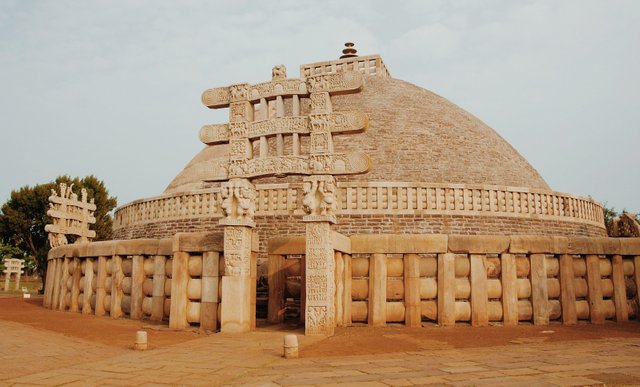The Great Stupa at Sanchi is one of the most important Buddhist monuments reflecting gem of Buddhist art and architecture. Located at Sanchi Town, Madhya Pradesh, India, this Stupa is the oldest stone structure in India that was built during the Mauryan period. Originally commissioned in the third century BCE by Emperor Ashok this huge hemispherical dome with a height of 12.2816.46 m (54.0 ft) consists of a central chamber where the relics of Lord Buddha are placed. Four ornamental gateways facing four directions and a balustrade surrounding the Stupa were later added in the first century BCE. A typical example of a Stupa and an excellent illustration of the development of Buddhist art and sculpture starting from the third century BC through the twelfth century AD, the Sanchi Stupa attracts hundreds of visitors from across the world. Enlisted as a UNESCO World Heritage Site since 1989, it is counted among the best conserved ancient Stupas of central India.
Foundation of the Stupa
The foundation of the Buddhist vihara at Sanchi that includes the great Sanchi Stupa was laid by one of the greatest Indian Emperors, Ashoka of the Maurya Dynasty who reigned over almost the entire Indian subcontinent from c. 268 to 232 BCE. He commissioned construction of the Stupa here after redistributing the mortal remains of Lord Buddha so as to build several Stupas in different locations across India to spread Buddhism. The present hemispherical edifice is double in diameter of the original brick structure built by Ashoka, consisting of the relics of Lord Buddha. A chatra that is an umbrella like structure made of stone crowned the hemispherical brick structure that was surrounded by a wooden railing. Queen Devi, wife of Ashoka and daughter of a merchant of Vidisha, who was born in Sanchi, supervised the construction of this monument. A sandstone pillar, inscribed with Schism Edict by Ashoka as also with ornate spiral Brahmi characters from the Gupta period resembling conch shells referred as ‘Shankhalipi’ or ‘shell-script’ by scholars, was erected in the site. While the lower portion of it is still grounded, the upper portions are kept under a canopy.
Information source "https://www.culturalindia.net/monuments/sanchi-stupa.html

Excellent pieces of information
Downvoting a post can decrease pending rewards and make it less visible. Common reasons:
Submit
Thanks
Downvoting a post can decrease pending rewards and make it less visible. Common reasons:
Submit